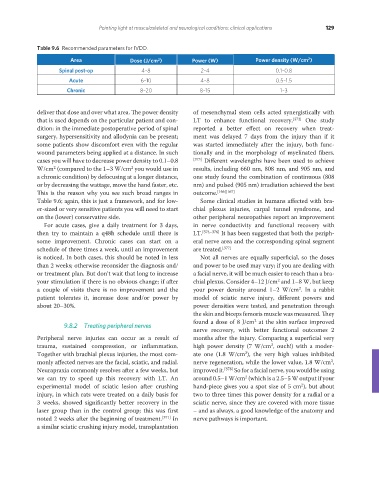Page 143 - Veterinary Laser Therapy in Small Animal Practice
P. 143
Pointing light at musculoskeletal and neurological conditions: clinical applications 129
Table 9.6 Recommended parameters for IVDD.
Area Dose (J/cm ) Power (W) Power density (W/cm )
2
2
Spinal post-op 4–8 2–4 0.1–0.8
Acute 6–10 4–8 0.5–1.5
Chronic 8–20 8–15 1–3
deliver that dose and over what area. The power density of mesenchymal stem cells acted synergistically with
that is used depends on the particular patient and con- LT to enhance functional recovery. [372] One study
dition: in the immediate postoperative period of spinal reported a better effect on recovery when treat-
surgery, hypersensitivity and allodynia can be present; ment was delayed 7 days from the injury than if it
some patients show discomfort even with the regular was started immediately after the injury, both func-
wound parameters being applied at a distance. In such tionally and in the morphology of myelinated fibers.
cases you will have to decrease power density to 0.1–0.8 [373] Different wavelengths have been used to achieve
2
2
W/cm (compared to the 1–3 W/cm you would use in results, including 660 nm, 808 nm, and 905 nm, and
a chronic condition) by defocusing at a longer distance, one study found the combination of continuous (808
or by decreasing the wattage, move the hand faster, etc. nm) and pulsed (905 nm) irradiation achieved the best
This is the reason why you see such broad ranges in outcome. [166][167]
Table 9.6; again, this is just a framework, and for low- Some clinical studies in humans affected with bra-
er-sized or very sensitive patients you will need to start chial plexus injuries, carpal tunnel syndrome, and
on the (lower) conservative side. other peripheral neuropathies report an improvement
For acute cases, give a daily treatment for 3 days, in nerve conductivity and functional recovery with
then try to maintain a q48h schedule until there is LT. [374–376] It has been suggested that both the periph-
some improvement. Chronic cases can start on a eral nerve area and the corresponding spinal segment
schedule of three times a week, until an improvement are treated. [377]
is noticed. In both cases, this should be noted in less Not all nerves are equally superficial, so the doses
than 2 weeks; otherwise reconsider the diagnosis and/ and power to be used may vary; if you are dealing with
or treatment plan. But don’t wait that long to increase a facial nerve, it will be much easier to reach than a bra-
your stimulation if there is no obvious change; if after chial plexus. Consider 4–12 J/cm and 1–8 W, but keep
2
a couple of visits there is no improvement and the your power density around 1–2 W/cm . In a rabbit
2
patient tolerates it, increase dose and/or power by model of sciatic nerve injury, different powers and
about 20–30%. power densities were tested, and penetration through
the skin and biceps femoris muscle was measured. They
2
9.8.2 Treating peripheral nerves found a dose of 8 J/cm at the skin surface improved
nerve recovery, with better functional outcomes 2
Peripheral nerve injuries can occur as a result of months after the injury. Comparing a superficial very
2
trauma, sustained compression, or inflammation. high power density (7 W/cm , ouch!) with a moder-
2
Together with brachial plexus injuries, the most com- ate one (1.8 W/cm ), the very high values inhibited
monly affected nerves are the facial, sciatic, and radial. nerve regeneration, while the lower value, 1.8 W/cm ,
2
Neurapraxia commonly resolves after a few weeks, but improved it. [378] So for a facial nerve, you would be using
2
we can try to speed up this recovery with LT. An around 0.5–1 W/cm (which is a 2.5–5 W output if your
2
experimental model of sciatic lesion after crushing hand-piece gives you a spot size of 5 cm ), but about
injury, in which rats were treated on a daily basis for two to three times this power density for a radial or a
3 weeks, showed significantly better recovery in the sciatic nerve, since they are covered with more tissue
laser group than in the control group; this was first – and as always, a good knowledge of the anatomy and
noted 2 weeks after the beginning of treatment. [371] In nerve pathways is important.
a similar sciatic crushing injury model, transplantation
REDONDO PRINT (4-COL BLEED).indd 129 08/08/2019 09:48

